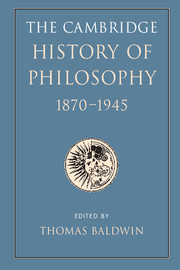Book contents
- Frontmatter
- Contents
- List of contributors
- Introduction
- I 1870–1914
- II 1914–1945
- 8 Logic and philosophy: the analytic programme
- 9 The diversity of philosophy
- 10 Knowledge, language, and the end of metaphysics
- 11 Philosophy and the exact sciences
- 12 Mind and its place in nature
- 51 Vitalism and emergence
- 52 Behaviourism and psychology
- 53 Gestalt psychology
- 54 Wittgenstein’s conception of mind
- 13 Philosophy and social science
- 14 Ethics, religion, and the arts
- 15 Law and politics
- Biobibliographical appendix
- Bibliography
- INDEX
- References
51 - Vitalism and emergence
from 12 - Mind and its place in nature
Published online by Cambridge University Press: 28 March 2008
- Frontmatter
- Contents
- List of contributors
- Introduction
- I 1870–1914
- II 1914–1945
- 8 Logic and philosophy: the analytic programme
- 9 The diversity of philosophy
- 10 Knowledge, language, and the end of metaphysics
- 11 Philosophy and the exact sciences
- 12 Mind and its place in nature
- 51 Vitalism and emergence
- 52 Behaviourism and psychology
- 53 Gestalt psychology
- 54 Wittgenstein’s conception of mind
- 13 Philosophy and social science
- 14 Ethics, religion, and the arts
- 15 Law and politics
- Biobibliographical appendix
- Bibliography
- INDEX
- References
Summary
While vitalism can be traced to ancient Greece (Aristotle’s On the Soul is a vitalist work), modern vitalism arose as a rejection of Descartes’s mechanistic view that plants, animals, and even living human bodies are kinds of machines. Early modern vitalists such Georg Ernest Stahl maintained that what distinguishes living things from nonliving things is that the former contain an irreducible component that is responsible for animating the body. By the start of the nineteenth century, however, a number of researchers had followed Antoine Laurent Lavoisier’s lead in applying the new chemical theory to physiology. And the debate between vitalists and mechanists became focused on whether it is possible to give chemical accounts of vital behaviour such as metabolisation, respiration, and fermentation (Asimov 1964). Many vitalists argued that an account of these vital behaviours would require the discovery of fundamental, vital forces, while mechanists argued that there are no fundamental vital forces, and that organic and inorganic processes differ only in complexity (see Bechtel and Richardson 1993 and 1998). By the close of the nineteenth century, mechanism appeared to be winning on the battlefronts of metabolisation, respiration, and fermentation. Nevertheless, vitalism had begun a powerful resurgence. In the last two decades of the century, biologists began to study the underlying mechanisms of developmental and regulative processes in organisms. And the work of Hans Driesch (1867–1941), one of the founders of this new field of experimental embryology, played a major role in igniting a new period of intense interest in vitalism that lasted well into the 1930s.
- Type
- Chapter
- Information
- The Cambridge History of Philosophy 1870–1945 , pp. 629 - 639Publisher: Cambridge University PressPrint publication year: 2003
References
- 2
- Cited by



